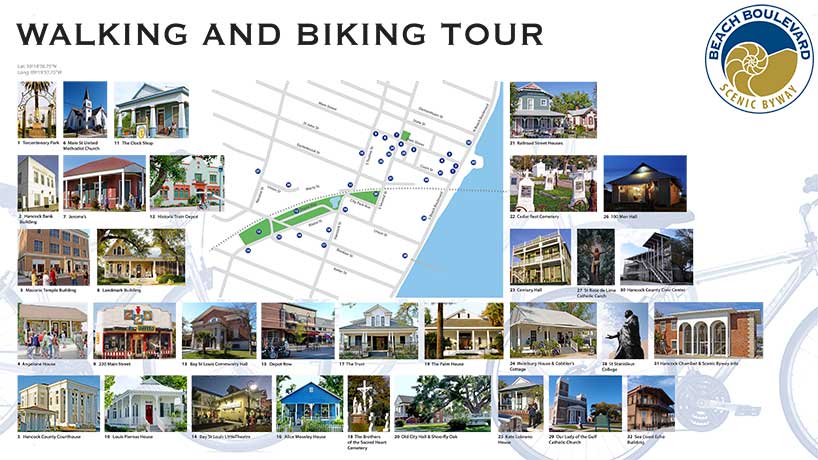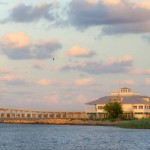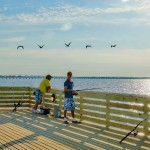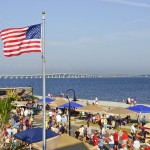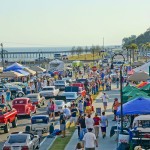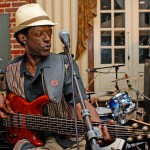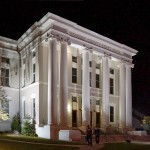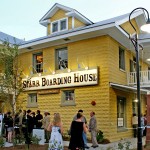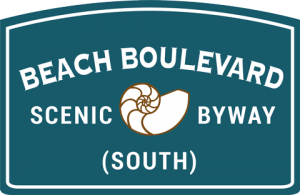
This section of the Beach Boulevard byway features a picturesque drive through the quaint communities of Bay St. Louis, Waveland and Clermont Harbor. It runs along the scenic sand beach and includes a three-mile walking and biking trail of downtown areas, historic and artistic amenities, restaurants, casinos and unique stores.
Here are some of the featured sites along the southern section of the Beach Boulevard byway.
Bay of St. Louis Art Walk & Heritage Trail

Historic Old Spanish Trail
Since there wasn’t a good way to travel along the Gulf Coast in the early 1900s, a project began to develop the Old Spanish Trail that would stretch from San Diego, California, to St. Augustine, Florida. The car trail in this area eventually became known as Highway 90, but one part of the highway construction veered off the original route and formed this section on the byway map.
Along the historic Old Spanish Trail and present day Ulman Avenue, visitors will see the Ave’ Maria Grotto and the St. Augustine Seminary. For many years, the seminary trained African American men for the priesthood. Students and patrons of the small chapel on the seminary grounds built the grotto for a place of meditation.
At the corner of Ulman Avenue and Dunbar Avenue (where the historic trail takes a southerly turn), visitors will find McDonald Park, which boasts a splash pad, playground, and restrooms, with more development to come.
Downtown Bay St. Louis

This portion of the downtown area is listed on the National Register of Historic Places as the Bay St. Louis Beach Multiple Resources Historic District. A must stop is the A&G Theater. The building is reflective of the late 1920s and also is listed on the National Register of Historic Places.
Old meets new in downtown delighting visitors and residents alike. A new seawall features ample green space to enjoy sunsets atop the bluff at the water’s edge, and a new pedestrian and biking pathway has been added. The James Rutherford Pier and a new Bay St. Louis Municipal Harbor are are now open, completing post Katrina waterfront improvements in “Old Town.”
Historic Hancock County Bank & Main Street Area
At the corner of Main Street is the Historic Hancock County Bank. As the oldest existing Hancock branch, it still serves as a small downtown bank with a very ornate interior and is home to a variety of banking artifacts. The building also served as a location of the Customs Office for the area.
Just off the scenic byway on Main Street and Court Street are exceptional specialty shops, art galleries, antique treasures, and exquisite restaurants, many of which are in original architecture buildings that were restored following Hurricane Katrina. It’s also home to a handful of historic sites such as the stately courthouse, which has been newly remodeled, yet preserved in certain sections to showcase original craftsmanship.
This location also is a celebration center for many events in downtown Bay St. Louis like BridgeFest and Cruisin’ the Coast. The area is closed to all traffic except for Cruisin’ the Coast traffic, a weeklong October event where vintage cars line Beach Boulevard, Main Street and Second Street.
Bay St. Louis Depot District

The area showcases several unique shops and restaurants, a community center, and a Little Theater. The Bay St. Louis Little Theater is located in a former general store that was portrayed as the Starr Boarding House in the movie This Property is Condemned, starring Natalie Wood, Robert Redford, Charles Bronson, John Provost (who played Timmy on the television series Lassie) and Mary Badham (who starred with Gregory Peck in To Kill a Mockingbird). Look for markers of the various scenes from the movie throughout the area and also relive the times when rail transportation was king.
Bay St. Louis French Catholic Area
Our Lady of the Gulf Catholic Church, originally built in 1847 but burned in a fire in 1907, illustrates the importance of the Catholic church within the community. The present building was rebuilt in 1908 and features stained glass windows handmade in Munich, Germany.
The historic St. Stanislaus College is located next to the church, which was established in 1854 by the Brothers of the Sacred Heart. The school is a college preparatory school that offers boarding, and since its founding, has hosted both international students and students from across the country. Part of the original school still exists, but portions of the school were lost to fire and hurricane damage during its nearly 160 years of existence.
Founded in 1926, St. Rose de Lima Catholic Church is one of the most vibrant and integrated churches in South Mississippi. The St. Rose Choir is nationally known and two CDs are credited to their name and one to the men’s choir. “Christ in the Oaks”, the mural across the sanctuary creates a sense of awe and majesty to all who enter.
Washington Street Pier & Beach Area
This area features two boat launches, a public pier, pavilion, parking area, bathrooms, beach access, and the Heritage Biking and Pedestrian Trail that links recreational resources, as well as scenic and historic resources along the Beach Boulevard Scenic Byway. The Heritage Trail is almost always in use and offers a picturesque place for recreational activities. The waterfront is available for walking, running, swimming, sailing and boating.

Sweetbay Hollow Birding Tower
If you are looking for a perfect birding spot along the Beach Boulevard Byway, just follow the signs between the Washington Street Pier in Bay St. Louis and the Garfield Ladner Pier in Waveland. Known as Sweetbay Hollow, it boasts a birding tower that was constructed by volunteers on a tract of land owned by the Land Trust for the Mississippi Coastal Plain. From this tower, various species of birds can be viewed in the surrounding wooded area and the nearby beach.
Downtown Waveland
Just off the Beach Boulevard Scenic Byway is Coleman Avenue, which boasts a new City Hall, a retail business complex, restaurants, a new library, and the Waveland Civic Center.
One of the city’s more popular landmarks is the Blue Star and Veterans Memorial, which was established in 2002 to honor veterans and their sacrifice, and has designated areas for meditation and reflection.
Buccaneer State Park
This natural treasure offers more than 200 premium campsites with full amenities, a disk golf course and the Pirate’s Alley Nature Trail. The park’s half-million gallon wave pool pulses in eight different patterns during different times of the day, making for a varied guest experience. The park also features two water slides and a separate facility for toddlers and younger children.
In addition, Buccaneer State Park features numerous historic landmarks. Long before it became a recreational haven on the Mississippi Sound, the park was known as Jackson Ridge. Archeological excavations are currently underway to determine the location of Sea Song, the family home of Andrew Jackson’s wife and the home he in lived for several years.
Bayou Cadet Fishing Village
Historically known as Bayou Cadet, it is now commonly referred to as Bayou Caddy. This area thrives on the seafood industry and its workers who harvest the Mississippi Sound, and the culture and lifestyle of this community reflect it.
The Bay of St. Louis provides an excellent shellfish nursery, and each season, shrimp make their way into the open waters of the Mississippi Sound and the Gulf of Mexico. Nearly 80 percent of the oysters harvested in Mississippi take place in Hancock County waters, or waters immediately adjacent to the county. One of the most productive reefs is the Square Handkerchief Reef, which is located offshore, and boats can be seen harvesting seafood in this area from nearly anywhere along South Beach Boulevard.

Clermont Harbor Area
Located between Buccaneer State Park and the scenic community of Clermont Harbor, this harbor and pier area offers breathtaking views of the Gulf and some of the best fishing and crabbing opportunities along the Beach Boulevard Byway.
An official site on the Mississippi Gulf Coast Birding Trail, visitors can view an extensive tidal wetland, along with the near shore birds that use this area for their habitat. The marshes change with the seasons, as do the birds that migrate to the area.
The area showcases a nod to Hancock County history. It was the site of the historic Grand Hotel and a fleet of stately boats and fishing cabins. Today, the area has been transformed into a vast wetland area that provides a habitat for birds and is a nursery for fish and other seafood.

